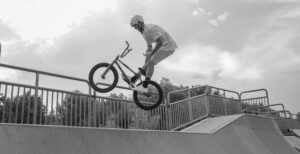The BMX bike is a specialized off-road racing bicycle that is designed for both racing and stunt riding. BMX bikes usually have only one gear and no brakes, which makes them lighter and easier to maneuver than other types of bicycles. Some BMX riders choose to ride without brakes, while others may use coaster brakes or hand-operated caliper brakes. BMX bikes are available in both freestyle and racing versions, and many riders use them for both purposes.
In this article, we’ll take a look at the question, “Do BMX bikes have brakes?” We’ll discuss the different types of brakes that may be used on BMX bikes.
Do BMX Bikes have Brakes:
The simple answer to this question is “it depends.” Some BMX riders choose to ride without brakes, while others may use coaster brakes or hand-operated caliper brakes. BMX bikes are available in both freestyle and racing versions, and many riders use them for both purposes. The type of brake that is best for a particular rider will depend on their riding style and the type of BMX bike that they are using.
BMX Racing Bike:
BMX racing bikes typically have 20-inch (51 cm) wheels and a spoke count of 36 or less. The frames are designed to be lightweight and stiff, with a low center of gravity. The handlebars are relatively low and wide, to give the rider more control when racing. BMX racing bikes also have a higher bottom bracket than other bicycles, which helps the rider pedal through tight turns without losing traction.
Coaster Brakes:
Coaster brakes are the most common type of brakes used on BMX bikes. Coaster brakes are operated by pedaling backward, which causes the brake pads to press against the rim of the wheel. Coaster brakes are simple to operate and require very little maintenance. However, coaster brakes can be less effective than other types of brakes in wet or muddy conditions.
Caliper Brakes:
Caliper brakes are operated by a lever that is mounted on the handlebars. Caliper brakes are more effective than coaster brakes in wet or muddy conditions. However, caliper brakes can be more difficult to operate and require more maintenance than coaster brakes.
Disc Brakes:
Disc brakes are the most effective type of brakes for BMX bikes. Disc brakes are operated by a lever that is mounted on the handlebars. Disc brakes are more effective than coaster brakes in wet or muddy conditions. However, disc brakes can be more difficult to operate and require more maintenance than coaster brakes.
BMX Freestyle Bike:
BMX freestyle bikes are designed for riders who want to perform tricks and stunts. BMX freestyle bikes have a variety of features that make them different from other types of BMX bikes. BMX freestyle bikes usually have wider tires, stronger frames, and stronger brakes than other types of BMX bikes.
Why Don’t BMX Bikes Have Front Brakes?
One of the first things you’ll notice when you compare a BMX bike to a regular bicycle is that BMX bikes don’t have front brakes. So, why is this?
The main reason is that BMX bikes are designed for stunt riding and racing, and having front brakes would get in the way of many of the tricks and moves that riders like to do. Additionally, front brakes can make it harder to do certain kinds of jumps and other stunts.
However, some BMX riders do choose to install front brakes on their bikes, particularly if they plan to use them for street riding or park riding where they’re more likely to encounter obstacles that they need to stop for.
Do BMX Bikes Have Rear Brakes?
All BMX bikes have rear brakes, and in fact, most BMX bikes have only rear brakes. This is because rear brakes provide enough stopping power for most riders, and they’re not as likely to get in the way when doing stunts as front brakes would be.
However, some stunt riders do choose to install both front and rear brakes on their BMX bikes. This gives them the ability to stop more quickly if they need to, but it also means that they have to be more careful when doing stunts so that they don’t accidentally engage the brakes and ruin their trick.
How Do Riders Stop Their BMX Bikes Without Brakes?
So how do BMX riders stop their bikes without brakes? Well, there are a few ways. The most common way is to simply skid to a stop. Skidding is when the rider locks up the wheels of their bike so that they stop rotating. This causes the bike to slide along the ground until it eventually comes to a stop.
Another way to stop a BMX bike without brakes is to do an emergency brake. An emergency brake is when the rider stands up on their pedals and uses their body weight to push down on the rear end of the bike, causing it to skid.
Finally, riders can also use their feet to slow down and stop their bikes. This is called the foot brake and is often used when riders are going down hills or want to come to a stop quickly. To do this, riders simply put their feet down on the ground next to the tires and use friction to slow the bike down.
What Brakes Do BMX Bikes Have?
BMX bikes typically have two types of brakes: coaster brakes and hand brakes. Coaster brakes are activated by pedaling backward, while hand brakes are activated by squeezing levers on the handlebars. Some BMX riders prefer coaster brakes because they are simpler to use, while others prefer hand brakes because they offer more stopping power. Ultimately, it is up to the rider to decide which type of brake is best for them.
Do All BMX Bikes Have Brakes?
No, not all BMX bikes have brakes. Some riders prefer to ride without brakes, while others may only have one type of brake on their bike. It is important to check local laws and regulations before riding without brakes, as it is illegal in some areas.
How Do I Choose the Right Brakes for My BMX Bike?
When choosing brakes for your BMX bike, it is important to consider your riding style and needs. If you will be doing mostly street riding, you may want to choose hand brakes for more stopping power. If you will be doing mostly park riding, you may want to choose coaster brakes for simplicity. Ultimately, it is up to the rider to decide which type of brake is best for them.
Reasons why a BMX Rider Might Not Use Brakes:
There are several reasons why a BMX rider might choose to ride without brakes. One reason is that it makes the bike lighter and easier to maneuver. Another reason is that it can help the rider perform stunts more easily. Some riders also believe that riding without brakes makes the sport more exciting and challenging.
The Risks of Riding BMX Without Brakes:
Despite the reasons why some BMX riders choose to ride without brakes, it is important to understand the risks involved. One of the most significant risks is that it can be very difficult to stop the bike if an emergency situation arises. This can put the rider and others around them in danger. Additionally, riding without brakes can make it more difficult to control the bike, which can lead to crashes.
How to Ride BMX Safely:
If you are interested in riding BMX, it is important to do so safely. This means always wearing a helmet and proper protective gear. It is also important to ride in areas that are designated for BMX riding and to avoid riding in traffic. Additionally, if you choose to ride without brakes, it is essential to be aware of the risks and take steps to mitigate them.
-Wear a helmet
-Wear proper protective gear
-Ride in designated areas
-Avoid riding in traffic
-Be aware of the risks of riding without brakes
-Take steps to mitigate the risks of riding without brakes
With these safety tips in mind, you can enjoy riding BMX while minimizing the risks.
Conclusion:
In conclusion, not all BMX bikes have brakes. Some riders prefer not to have them, as they can be considered a hindrance when performing certain tricks. However, many riders do choose to have brakes on their BMX bikes, as they can provide an extra level of safety and control. If you’re unsure whether or not you want brakes on your BMX bike, it’s best to consult with a knowledgeable salesperson or another rider who can offer guidance.





